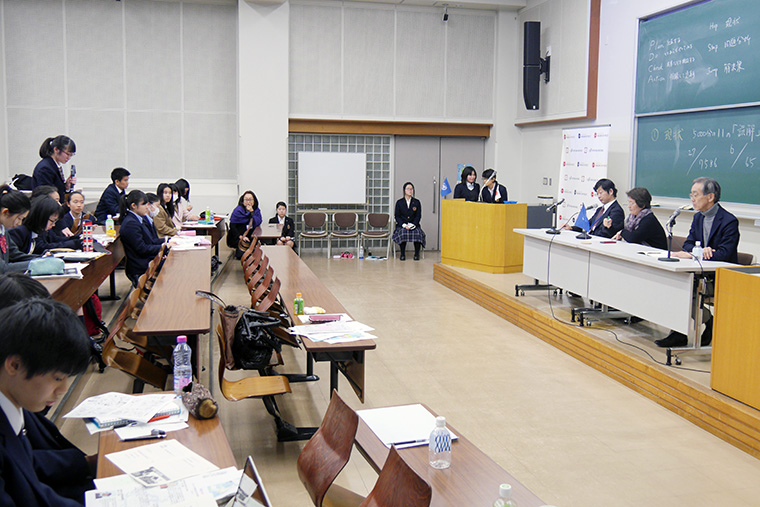“SGH Tamagawa Academy Model United Nations Conference” is organized by Tamagawa Academy but prepared and operated by students. This year is its second year, and we aimed to make the seminars and study sessions more substantial for the beginners in the Model United Nations.

This year’s agenda was “refugees in conflict situations, IDPs problem”. We invited three teachers on the day before the meeting and held a “refugee problem workshop”, which had 50 participants from six schools attend with the goal of deepening their understanding of the refugee problem.
The first speaker was Saburo Takizawa, professor of the Graduate School at Toyo Eiwa University. He clearly explained a lot of information with exchanged questions and gave some interesting anecdotes so that students could understand the fact that currently 3% of the world population is made up of refugees. Also he spoke about the nation system, how conflicts and the gap between rich and poor can conspire to create makes refugees, as well as the methods to support refugees, and so on.

The Next lecture was given by Naoko Obi, deputy representative of the UNHCR Office in Japan. Presenting case studies, she explained some possible challenges and solutions to the refugee problem. “Since there are not many countries who accept refugees, and this problem is worsening, I am always thinking about how we can solve this problem. I want you high school students to think together to create solutions“.

The last speaker was Hiroshi Kimizuka of the Ministry of Justice Immigration Bureau, referee division. For 25 years of his carrier he worked in immigration management. He talked about Japan’s refugee relief efforts.
“Japan is often said to be “secluded from refugees” in the world, but we cannot compare in the same because the environment and reality of life are different in different countries. It is important to support refugees how Japan can “.

A question-and-answer session was held after the lecture for more than one hour, and he answered the students’ questions.

Finally, about 140 students from 16 SGH schools gathered and the “SGH Tamagawa Academy 1 day Model United Nations Conference” began.
After the opening ceremony was held at 9 o’clock in the morning, the “Model United Nations Conference” started in two separate venues; A and B. Students prepared to act as an ambassador for each country while holding repeated discussions and negotiations to find answers which could lead to furthering international interests while protecting their own.

The “Negotiation Paper”, on which the positions and proposals of each country is written, was posted in the venue for reference to the approach.

After lunch, each ambassador began to work further on completing the draft referred as “DR”. Each explain the country’s refugee problems through speeches, calling for countries to agree, or using the negotiation time known as the “Unmoderated. Caucus”. They repeated individual negotiations, discussions, and made compromises.


In both venues, there was an increase in scenes of numbers of people gathering around one of the ambassadors to listen to his opinions. Gradually solid national policy was made and the conference moved toward the final stage.


Finally, with Germany and the United States in the A venue, and Myanmar, the United States, and Hungary in the B venue, the DR’s were submitted. There followed, descriptions, final negotiations, and then the vote on the resolution was held.
The United States’ DR in venue A, and all three countries’ in venue B were adopted and the conference was closed.

At last, all students gathered for the Closing Ceremony. There were slideshows which reflected the day, introduction of the DRs, and feedback from the chairman, the awards ceremony was held with a drum roll with students drumming on the desks. That showed a sense of unity beyond the differences between regions and schools.


As the host school, many students worked a lot on preparation, from making materials to operating the conference. Everyone’s feelings of trust and support worked to ensure the plans made were brought to fruition.
Students who participated felt a great response from the communication about what “country” can mean rather than merely individuals working in the global field.
Lecturer profile

Saburo Takizawa
He entered the Ministry of Justice after completing a doctoral degree at Tokyo Metropolitan University. After completing his graduate degree at Haas School of Business, University of California, Berkeley, he was accepted by the UNHCR headquarters in Geneva in 1981. After working in UNIDO (United Nations Industrial Development Organization) as Treasurer at the Vienna headquarters, he moved to the Geneva headquarters Finance Bureau of the UNHCR (United Nations High Commissioner for Refugees) working from 2002 to 2006. From 2007 to August 2008 he was a delegate at the UNHCR. After working as visiting professor in United Nations University, he is in this position currently. He is also an American Certified Public Accountant.
Naoko Obi
She completed the master’s program in Political Science at the University of Windsor, Canada, and Administrative Studies at International Christian University. She also received a doctoral degree in Public Administration at International Christian University Graduate School. Since 1987, she worked for the UNHCR. Currently, she is a senior international protection officer and a senior policy evaluation and analysis officer in regional offices such as Kenya, the Philippines and Thailand, and also at the headquarters in Geneva, Switzerland.
Kimizuka Hiroshi
After graduated from Meiji University, Department of Political Science and Economics, he joined the Legal Affairs Bureau. He is responsible for HR organization, policy making, immigration examination, and alien registration at the Immigration Bureau. In the past, he was in the Legal Affairs Bureau’s Immigration office, in charge of the Registration Division and Affairs Division’s Immigration Information Management Office. In 2000 to 2003 he also served as First Secretary (Political Affairs) of the Embassy of Japan in Thailand



